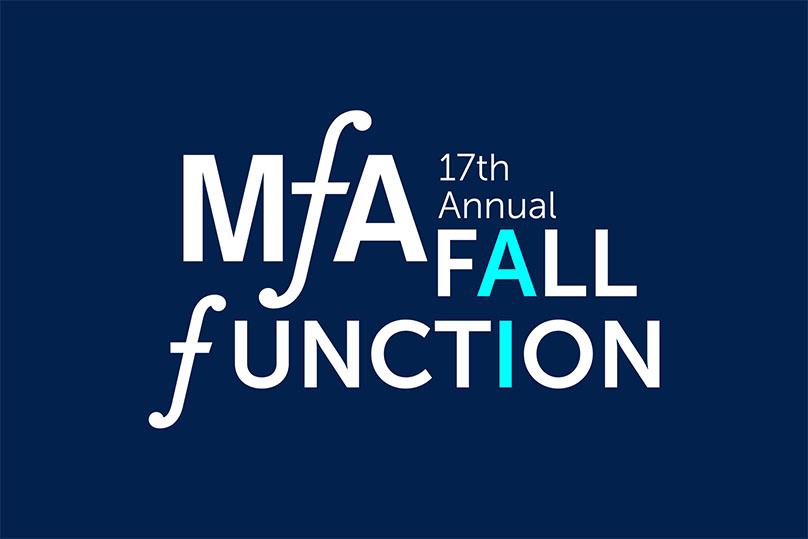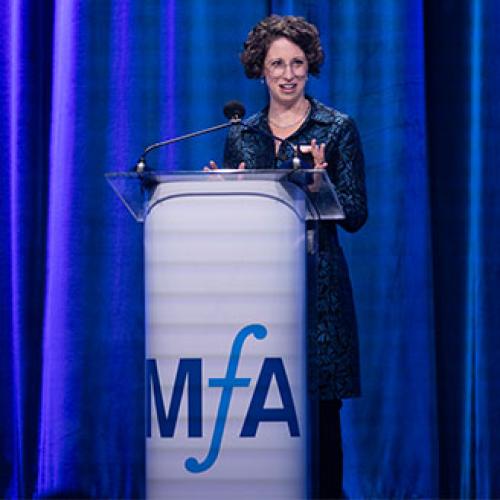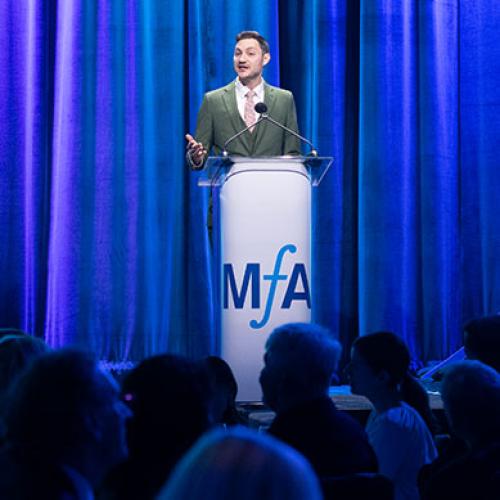

NEW YORK, NY – Math for America’s (MƒA) 17th Annual Fall ƒunction gala, held Saturday, November 8 at the Marriott Marquis in Times Square, celebrated nearly 1,000 outstanding New York City mathematics and science teachers for strengthening our education system and positively impacting their schools, colleagues, and students. This year’s event brought together more than 1,300 leaders in education for a grand celebration with a focus on Artificial Intelligence (AI). What does it mean for our classrooms? How do we encourage innovation that improves learning without replacing the human connection? How can it support our teachers, their students, and us as human beings?
Along with a cocktail reception and dinner, this year's Fall ƒunction featured a keynote address by Dr. Rebecca Willett, Worah Family Professor of Statistics and Computer Science in the Wallman Society of Fellows at the University of Chicago. Willet stated "investing in applied AI without understanding the underlying mathematical foundations is like investing in biotech without understanding biology." In her talk, she explored the mathematics that power AI, how these ideas manifest in the real world, and how they can inspire students to view mathematics in a new light.
Willett is the Director of AI at the University of Chicago Data Science Institute. Her research is focused on machine learning foundations, scientific machine learning, and signal processing. Willett received the inaugural Data Science Career Prize from the Society of Industrial and Applied Mathematics in 2024, was named a Fellow of the Society of Industrial and Applied Mathematics in 2021 and was named a Fellow of the IEEE in 2022. She is the Deputy Director for Research at the NSF-Simons Foundation National Institute for Theory and Mathematics in Biology, Deputy Director for Research at the NSF-Simons Institute for AI in the Sky (SkAI), and Faculty Director of the Eric and Wendy Schmidt AI in Science Postdoctoral Fellowship.

Dr. Rebecca Willett, Worah Family Professor of Statistics and Computer Science in the Wallman Society of Fellows at the University of Chicago.

Samuel Keener, MƒA Master Teacher Emeritus veteran math and computer science educator.
In addition, MƒA Master Teacher Emeritus Samuel Keener shared his thoughts how AI can support teachers and students, and how to prepare students for an increasingly AI-dependent future. He spoke about his journey from “class clown” to Master Teacher, highlighting how curiosity, creativity, and community shaped his growth as an educator. Through stories of experimentation, failure, and innovation, he reminded us that teaching is an act of courage and that the next frontier of education will be defined by those willing to explore, adapt, and lead with imagination.
Keener is a veteran math and computer science educator with over a decade of experience teaching and inspiring students. He is passionate about helping young people build confidence as problem solvers and discovering the connections between computational thinking and the world around them. In recent years, Keener has focused on exploring how artificial intelligence can transform teaching and learning. He experiments with ways AI can spark curiosity, deepen understanding, and give students more freedom to be creative and collaborative. Samuel is a proud MƒA Master Teacher Emertius and credits the MƒA community for encouraging him to bring innovative ideas — including AI — into his classroom and to share them with other educators.
MƒA teachers teach in close to 400 New York City schools across all five boroughs reaching approximately 100,000 students. Throughout their fellowships, MƒA teachers are provided powerful opportunities to build relationships and get new ideas from similarly dedicated peers. The MƒA community being recognized at the event includes more than 700 high school teachers, more than 175 middle school teachers, and more than 60 elementary school teachers, with more than 400 teaching mathematics and more than 500 teaching science.

